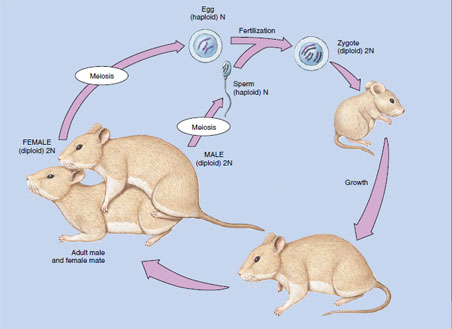Bisexual Reproduction
Bisexual Reproduction
Bisexual reproduction is the production
of offspring formed by the union of
gametes from two genetically different
parents (Figures 7-1C and D, and 7-2).
The offspring will thus have a new
genotype different from either of the
parents. The individuals sharing parenthood
are characteristically of different sexes, male and female (there are
exceptions among sexually reproducing
organisms, such as bacteria and
some protozoa in which sexes are
lacking). Each has its own reproductive
system and produces only one
kind of germ cell, spermatozoon or
ovum, but never both. Nearly all vertebrates
and many invertebrates have
separate sexes, and such a condition is
called dioecious (Gr. di-, two, + oikos, house). An exception to this is
found in individual animals that have
both male and female reproductive
organs, a condition which is called monoecious (Gr. monos, single, + oikos, house). These animals are called hermaphrodites (from a combination
of the names of the Greek god Hermes
and goddess Aphrodite) and this form
of reproduction will be described in
the next section.
The distinction between male and female is based, not on any differences in parental size or appearance, but on the size and mobility of the gametes they produce. The ovum (egg) is produced by the female. Ova are large (because of stored yolk to sustain early development), nonmotile, and produced in relatively small numbers. The spermatozoon (sperm) is produced by the male. Sperm are small, motile, and produced in enormous numbers. Each is a stripped-down package of highly condensed genetic material designed for the single purpose of reaching and fertilizing an egg.
There is another crucial event that distinguishes sexual from asexual reproduction: meiosis, a distinctive type of gamete-producing nuclear division). Meiosis differs from ordinary cell division (mitosis) in being a double division. The chromosomes split once, but the cell divides twice, producing four cells, each with half the original number of chromosomes (the haploid number). Meiosis is followed by fertilization in which two haploid gametes are combined to restore the normal (diploid) chromosomal number of the species.
The new cell (zygote), which now begins to divide by mitosis, has equal numbers of chromosomes from each parent and accordingly is different from each. It is a unique individual bearing a recombination of parental characteristics. Genetic recombination is the great strength of sexual reproduction that keeps feeding new genetic combinations into the population.
Many unicellular organisms reproduce both sexually and asexually. When sexual reproduction does occur, it may or may not involve male and female gametes. Sometimes two mature sexual parents merely join together to exchange nuclear material or merge cytoplasm (conjugation, Protozoan Groups). Distinct sexes do not exist in these cases.
The male-female distinction is more clearly evident in most animals. Organs that produce germ cells are called gonads. The gonad that produces sperm is a testis and that which forms eggs is an ovary . Gonads represent the primary sex organs, the only sex organs found in certain groups of animals. Most metazoa, however, have various accessory sex organs (such as penis, vagina, uterine tubes, and uterus) that transfer and receive germ cells. In the primary sex organs the germ cells undergo many complicated changes during their development, the details of which are described later.
 |
| Figure 7-2 A sexual life cycle. The life cycle begins with haploid germ cells, formed by meiosis, combining to form a diploid zygote, which grows by mitosis to an adult. Most of the life cycle is spent as a diploid organism. |
The distinction between male and female is based, not on any differences in parental size or appearance, but on the size and mobility of the gametes they produce. The ovum (egg) is produced by the female. Ova are large (because of stored yolk to sustain early development), nonmotile, and produced in relatively small numbers. The spermatozoon (sperm) is produced by the male. Sperm are small, motile, and produced in enormous numbers. Each is a stripped-down package of highly condensed genetic material designed for the single purpose of reaching and fertilizing an egg.
There is another crucial event that distinguishes sexual from asexual reproduction: meiosis, a distinctive type of gamete-producing nuclear division). Meiosis differs from ordinary cell division (mitosis) in being a double division. The chromosomes split once, but the cell divides twice, producing four cells, each with half the original number of chromosomes (the haploid number). Meiosis is followed by fertilization in which two haploid gametes are combined to restore the normal (diploid) chromosomal number of the species.
The new cell (zygote), which now begins to divide by mitosis, has equal numbers of chromosomes from each parent and accordingly is different from each. It is a unique individual bearing a recombination of parental characteristics. Genetic recombination is the great strength of sexual reproduction that keeps feeding new genetic combinations into the population.
Many unicellular organisms reproduce both sexually and asexually. When sexual reproduction does occur, it may or may not involve male and female gametes. Sometimes two mature sexual parents merely join together to exchange nuclear material or merge cytoplasm (conjugation, Protozoan Groups). Distinct sexes do not exist in these cases.
The male-female distinction is more clearly evident in most animals. Organs that produce germ cells are called gonads. The gonad that produces sperm is a testis and that which forms eggs is an ovary . Gonads represent the primary sex organs, the only sex organs found in certain groups of animals. Most metazoa, however, have various accessory sex organs (such as penis, vagina, uterine tubes, and uterus) that transfer and receive germ cells. In the primary sex organs the germ cells undergo many complicated changes during their development, the details of which are described later.




